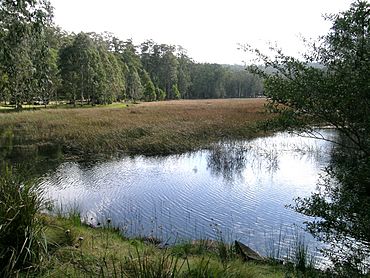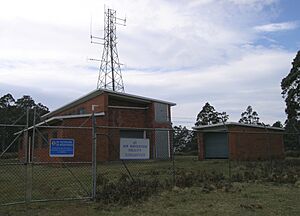Mummel Gulf National Park facts for kids
Quick facts for kids Mummel Gulf National ParkNew South Wales |
|
|---|---|
|
IUCN Category II (National Park)
|
|

New Country Swamp, Mummel Gulf National Park
|
|
| Nearest town or city | Walcha |
| Established | 1999 |
| Area | 122 km2 (47.1 sq mi) |
| Managing authorities | NSW National Parks and Wildlife Service |
| Website | Mummel Gulf National Park |
| See also | Protected areas of New South Wales |
Mummel Gulf National Park is a special protected area in New South Wales, Australia. It's about 487 kilometers north of Sydney by road. You can find it about 50 kilometers southeast of Walcha on an unsealed road called Enfield Forest Road. It's also about 12 kilometers south of the Oxley Highway.
The Mummel River has carved a very deep, V-shaped valley or gorge here. This gorge is more than 400 meters deep in some parts.
Contents
Plants and Animals of Mummel Gulf
Mummel Gulf National Park is home to many different types of trees and plants. It protects tall, open eucalyptus forests on the southeastern slopes of the New England region.
Forest Types and Trees
In the park, you can find wet sclerophyll forests. These are forests with hard-leaved plants that can handle dry conditions. Higher up in the park, around Porters Camp, there are snow gum (Eucalyptus pauciflora) forests. The land here drops from 1,450 meters down to 470 meters.
Some of the main trees in the older forests include messmate (Eucalyptus obliqua) and mountain ribbon gum (Eucalyptus nobilis). Other trees you might see are silvertop stringybark (Eucalyptus laevopinea), blue gum (Eucalyptus saligna), diehard stringybark (Eucalyptus cameronii), and New England blackbutt (Eucalyptus andrewsii).
A plant called broad-leaved pepperbush (Tasmannia purpurascens) grows here, which is the furthest north it can be found. Many kinds of shrubs also bloom with beautiful flowers during spring and summer.
Rainforest Areas
If you explore the remote central and southern parts of the park, you'll find moist subtropical rainforests. Here, you can see a mix of corkwood, sassafras (Doryphora sassafras), large tree ferns (Dicksonia), and silver sycamore (Cryptocarya glaucescens).
Threatened Wildlife
The park is also a safe home for many animals, including some that are threatened. These include the koala, tiger quoll, sugar glider, yellow-bellied glider, superb lyrebird, boobook owl, sooty owl, powerful owl, tawny frogmouth, and parma wallaby.
History of Mummel Gulf National Park
This area was once the border between two Aboriginal groups: the Nganyaywana people from the Northern Tablelands and the Danggati people from the valleys leading up to the tableland.
Early European Exploration and Settlement
In September 1818, an explorer named John Oxley passed by Apsley Falls and traveled east through this area. He was on his way to Port Macquarie. Soon after, people who cut down trees for timber and settlers without official permission started to arrive.
The Wool Road, which is now the Oxley Highway, was built here in 1842. It was built by convicts to connect the wool-growing town of Walcha with Port Macquarie. Some parts of the park were used for cutting down trees, but only small sections were completely cleared. Some areas were also used for grazing cattle and for small-scale mining of a metal called manganese.
Park Creation and Protection
In the 1970s, the Enfield and Riamukka State Forests grew bigger. They included the steep areas where the Mummel River flows. The Bicentennial National Trail, a long walking and riding trail, follows the Mummel Forest Road to the east of the park.
There are also some important facilities in the northern part of the park. These include the Porters (Camp) air navigation facility and Country Energy towers, which are located at 1,448 meters above sea level.
In 1992, a group called the North-East Forest Alliance (NEFA) protested against logging in this area. They set up a camp where the park is now. Their protests led to an agreement to stop logging so that NEFA and the state Forestry Commission could study the area together. Because of these efforts and a regional forest agreement, Mummel Gulf National Park was officially created in 1999.
Park Management and Challenges
The park faces challenges from some wild animals and weeds.
Controlling Wild Animals
Wild pigs and wild dogs live in the park. The National Parks and Wildlife Service (NPWS) staff work to control these animals. They use pig trapping and shooting programs. There's also a program to control wild dogs by placing bait on the ground. This program is done with Forests NSW and private landowners.
Managing Weeds
Two main weeds are a concern in the park: Crofton weed (Ageratina adenophora) and blackberry (Rubus fruticosus). Park staff work to remove these plants to protect the native species.
Visiting Mummel Gulf National Park
Access and Roads
The main gravel road into the park can be used by all vehicles. However, it's a good idea to have a four-wheel drive (4WD) vehicle if the weather is wet. The Panhandle Fire Trail is a 9.5-kilometer trail inside the park that is only suitable for 4WD vehicles.
Camping and Facilities
New Country Swamp has a basic camping area. It has toilets, picnic tables, and barbecues. This camping spot is about 13 kilometers from the highway and inside the National Park. The campsites are good for camper trailers or for camping right next to your vehicle. However, they are not suitable for caravans.
See also
 In Spanish: Parque nacional Golfo de Mummel para niños
In Spanish: Parque nacional Golfo de Mummel para niños



